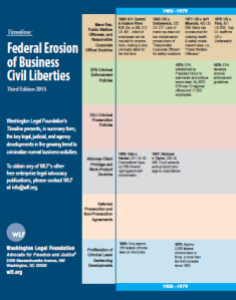Originally published at Washington Legal Foundation by
David Debold | 11/13/15
David Debold, Partner, Gibson, Dunn & Crutcher LLP
Editor’s Note: This is the first in a series of six guest commentary posts that will address the six distinct topic areas covered in Washington Legal Foundation’s recently released Timeline: Federal Erosion of Business Civil Liberties.
Two developments identified in WLF’s helpful Timeline—the proliferation of new criminal laws affecting businesses, and the evolution of federal sentencing law over time—would be topics of significant interest if either had unfolded without the other. The combination of the two, however, has posed a serious threat to the civil liberties of the American business community. Not only have vastly greater categories of conduct become eligible for criminal prosecution, the stakes in such prosecutions—for businesses, their owners, and their leadership—have increased substantially. As a result, conduct that had long been either lawful or merely the basis for a civil or administrative proceeding can now trigger a criminal investigation and prosecution ending with very substantial fines and lengthy prison terms.
There are many explanations for these parallel developments in the law, but the Timeline shows that perhaps the most important factor in the proliferation of new criminal laws is Congress’s decision to give administrative agencies the power to draft regulations that can form the basis for criminal prosecutions. No longer is it enough for businesses to consult the U.S. Code to determine which conduct violates criminal law; they must now wade through the even more dense Code of Federal Regulations to see whether an agency has adopted rules that allow for criminal prosecution if the agency’s requirements are not obeyed. This is particularly worrisome because it pushes the important job of drafting criminal law from our elected representatives to administrative bodies that are far from directly accountable to the people. Moreover, instead of the usual process, in which legislation creating new crimes must pass both houses of Congress and be signed by the President, it now takes only the “vote” of an administrative agency within the Executive Branch to achieve the same result. And with so many agencies separately exercising this power, the number of criminal prohibitions has mushroomed.

WLF Timeline chart
Our elected representatives share responsibility for this situation in a more direct manner too. Congress often responds reflexively to publicity about potentially blameworthy conduct (think of Enron or the 2008 financial crisis) by creating new federal crimes before carefully considering whether existing laws already made the conduct illegal. (It does little good to expand the scope of conduct subject to prosecution if proper enforcement of existing laws would get at the root of a problem.) As shown elsewhere in the Timeline, this type of congressional reaction has also included a watering down of mens rea requirements, making it easier for prosecutors to turn good-faith disagreements about the lawfulness of certain conduct into fodder for criminal prosecutions.
Similar explanations can be found for the significant upward trend in federal criminal penalties. When Congress criminalizes new conduct, it also tends to “supersize” the penalties—for new and old offenses alike. In response to the infamous savings-and-loan crisis of the 1980s, for example, Congress increased the prison term for many fraud-based bank offenses to 30 years—six times higher than the maximums then in place for mail fraud and wire fraud. And after Enron and WorldCom, Congress passed Sarbanes-Oxley, which included higher statutory penalties for fraud and a directive encouraging the United States Sentencing Commission to beef up the sentencing guidelines ranges for those offenses. In neither instance was there good reason to believe that the problem was an inability to impose harsh enough sentences. In point of fact, a wealth of research data shows that certainty of punishment—not severity—is the key to deterrence, especially in white-collar cases. The decision to increase penalties in Sarbanes-Oxley was particularly unjustified because the Sentencing Commission had just approved higher sentencing ranges for economic crimes that were due to take effect later that year.
For many companies, the threat of a criminal conviction carries so many negative collateral consequences (indictment alone doomed Arthur Andersen) that the only safe option is to pursue a non-prosecution or deferred-prosecution agreement with the government. That development, also chronicled on the WLF Timeline, makes for superb irony. One of the central purposes of the Sentencing Reform Act, which created the Sentencing Commission, was to improve consistent treatment of violators through transparent and principles-based sentencing, with appellate review available to police even-handed application of the law. But as more and more business conduct is criminalized, companies find themselves negotiating settlements with the Department of Justice outside of the usual criminal-justice process in order to avoid a criminal record. Companies therefore find themselves paying huge penalties, not much different from the fines a judge might impose following a guilty plea or trial. The critical difference is that these dispositions occur with little or no court involvement, meaning less oversight for consistency and transparency.
This application of the law of unintended consequences is not a crime (at least not yet), but it certainly is one of the many unfortunate byproducts for our commercial sector of having too many criminal laws with ever-increasing penalties.
Next post, Monday, November 16: Matthew Kaiser on Mens Rea, Public Welfare Offenses, and Responsible Corporate Officer Doctrine